class: center, middle, inverse, title-slide .title[ # The shape of things to come ] .subtitle[ ## Exploring the mathematical shape of plants ] .author[ ### <strong>Erik Amézquita</strong> <br> — <br> Computational Mathematics, Science, and Engineering <br> Michigan State University <br> — ] .date[ ### 2023-04-11 ] --- background-image: url("../../img/endlessforms.png") background-size: 150px background-position: 89% 7% class: inverse # Plant morphology <div class="row"> <div class="column" style="max-width:50%"> <iframe width="375" height="210" src="https://www.youtube-nocookie.com/embed/oM9kAq0PBvw?controls=0" frameborder="0" allow="accelerometer; autoplay; encrypted-media; gyroscope; picture-in-picture" allowfullscreen></iframe> <iframe width="375" height="210" src="https://www.youtube-nocookie.com/embed/V39K58evWlU?controls=0" frameborder="0" allow="accelerometer; autoplay; encrypted-media; gyroscope; picture-in-picture" allowfullscreen></iframe> </div> <div class="column" style="max-width:50%"> <iframe width="375" height="210" src="https://www.youtube-nocookie.com/embed/efF5PSvFQ2A?controls=0" frameborder="0" allow="accelerometer; autoplay; encrypted-media; gyroscope; picture-in-picture" allowfullscreen></iframe> <iframe width="375" height="210" src="https://www.youtube-nocookie.com/embed/qkOjHHuoUhA?controls=0" frameborder="0" allow="accelerometer; autoplay; encrypted-media; gyroscope; picture-in-picture" allowfullscreen></iframe> </div> </div> <p style="font-size: 24px; text-align: right; font-family: 'Yanone Kaffeesatz'">Check out more 3D X-ray CT scans at <a href="https://www.youtube.com/@endlessforms6756">youtube.com/@endlessforms6756</a></p> --- background-image: url("../../img/cmse_logo.svg") background-size: 150px background-position: 1% 50% class: center # My research: Crossing and merging bridges <div class="row"> <div class="column" style="width:15%"> </div> <div class="column" style="max-width:15%"> <a href="https://doi.org/10.1093/insilicoplants/diab033" target="_blank"><img style="padding: 0 0 0 0;" src="../figs/S017_L3_1.gif"></a> </div> <div class="column" style="max-width:18%"> <a href="https://doi.org/10.1002/ppp3.10333" target="_blank"><img style="padding: 0 0 0 0;" src="../../citrus/figs/SR01_L01_black_exocarp.gif"></a> </div> <div class="column" style="max-width:25%"> <img style="padding: 0 0 0 0;" src="../../arabidopsis/figs/Day7_110921_U112-3_pot0_leaf_X.gif"> </div> <div class="column" style="max-width:25%"> <img style="padding: 0 0 0 0;" src="../../walnuts/figs/2014SBa_R5_T81_meat_2.gif"> </div> </div> <div class="row"> <div class="column" style="width:15%"> <p style="font-size:5px">—</p> </div> <div class="column" style="max-width:28%"> <a href="https://plantsandpython.github.io/PlantsAndPython/00_Opening_page.html" target="_blank"><img style="padding: 0 0 0 0;" src="../../tutorials/figs/plants_and_python_group_photo.jpg"></a> </div> <div class="column" style="max-width:50%"> <a href="https://doi.org/10.1073/pnas.2217564120" target="_blank"><img style="padding: 0 0 0 0;" src="../../journal_diversity/figs/frequencies_globe_inv.jpg"></a> </div> </div> <div class="list" style="font-size: 10px; text-align: left;"> <ul> <li>Marks <em>et al.</em> (2023) A critical analysis of plant science literature reveals ongoing inequities. DOI: <a href="https://doi.org/10.1073/pnas.2217564120" target="_blank">10.1101/2022.10.15.512190</a></li> <li><strong>A</strong> <em>et al.</em> (2022) The shape of aroma: measuring and modeling citrus oil gland distribution. DOI: <a href="https://doi.org/10.1002/ppp3.10333" target="_blank">10.1002/ppp3.10333</a></li> <li><strong>A</strong> <em>et al.</em> (2022) Genomics data analysis via spectral shape and topology. DOI: <a href="https://doi.org/10.48550/arXiv.2211.00938" target="_blank">10.48550/arXiv.2211.00938</a></li> <li>VanBuren<em>et al.</em> (2022) Teaching tools in plant biology. Plants and Python, coding from scratch in the plant sciences. DOI: <a href="https://doi.org/10.1093/plcell/koac187" target="_blank">10.1093/plcell/koac187</a>.</li> <li><strong>A</strong> <em>et al.</em> (2021) Measuring hidden phenotype: Quantifying the shape of barley seeds using the Euler Characteristic Transform. DOI: <a href="https://doi.org/10.1093/insilicoplants/diab033" target="_blank">10.1093/insilicoplants/diab033</a></li> <li><strong>A</strong> <em>et al.</em> (2020) The shape of things to come: Topological data analysis and biology, from molecules to organisms. DOI: <a href="https://doi.org/10.1002/dvdy.175" target="_blank">10.1002/dvdy.175</a></li> </ul> </div> --- # The shape of things to come <div class="row" style="font-family: 'Yanone Kaffeesatz'; font-size:22px;"> <div class="column" style="max-width:33%"> <p style="line-height:0;text-align: center; font-size:28px">The shape of adaptability</p> <img style="padding: 0 70px;" src="../figs/S017_L3_1.gif"></img> <img style="padding: 0 55px;" src="../figs/ecc_X.gif"></img> <p style="text-align: center;">Topological Data Analysis</p> <p style="text-align: center;">Euler Characteristic Transform</p> </div> <div class="column" style="max-width:33%"> <p style="line-height:0;font-size:28px;text-align: center;">The shape of development</p> <img style="padding: 0 60px;" src="../../citrus/figs/SR01_L01_black_exocarp.gif"></img> <img style="padding: 0 27px;" src="../../citrus/figs/SW03_CRC1241-B_12B-4-3_L00_lambproj_v.jpg"></img> <p style="text-align: center;">Ellipsoidal modeling</p> <p style="text-align: center;">Directional statistics</p> </div> <div class="column" style="max-width:33%"> <p style="line-height:0;font-size:28px;text-align: center;">The shape of domestication</p> <img style="padding: 0 35px;" src="../../walnuts/figs/2014SBa_R5_T81_meat_2.gif"></img> <img style="padding: 0 10px;" src="../../walnuts/figs/kernel_volume_vs_nut_volume.png"></img> <p style="text-align: center;">Allometry of multiple tissues</p> <p style="text-align: center;">Convexity indices</p> </div> </div> --- class: inverse, middle, center # 1. Quantifying the barley morphology ## Brewing with the Euler Characteristic Transform <img src="../figs/amezquita_etal_2021.png" width="400" style="display: block; margin: auto;" /> --- <div class="row"> <div class="column" style="max-width:44%"> <a href="https://kizilvest.ru/20150827-v-kizilskom-rajone-nachalas-uborochnaya-strada/" target="_blank"><img style="padding: 0 0 0 0;" src="../figs/barley_kizilskoye.jpg"></a> <a href="https://ipad.fas.usda.gov/highlights/2008/11/eth_25nov2008/" target="_blank"><img style="padding: 0 0 0 0;" src="../figs/barley_ethiopia.gif"></a> <a href="https://www.doi.org/10.1007/978-1-4419-0465-2_2168" target="_blank"><img style="padding: 0 0 0 0;" src="../figs/barley_historical_expansion.jpg"></a> </div> <div class="column" style="max-width:44%"> <a href="https://www.resilience.org/stories/2020-03-09/the-last-crop-before-the-desert/" target="_blank"><img style="padding: 0 0 0 0;" src="../figs/barley_morocco.jpg"></a> <a href="https://www.tibettravel.org/tibetan-culture/highland-barley.html" target="_blank"><img style="padding: 0 0 0 0;" src="../figs/barley_seed_tibet.jpg"></a> <a href="https://www.nationalgeographic.co.uk/travel/2020/05/photo-story-from-barley-fields-to-whisky-barrels-in-rural-scotland" target="_blank"><img style="padding: 0 0 0 0;" src="../figs/barley_seed_scotland_cropped.jpg"></a> </div> <div class="column" style="max-width:8%; font-size: 15px;"> <p style="text-align: center; font-size: 30px; line-height: 1em;"> <strong> Barley across the world </strong></p> <p>Kiliskoye (Chelyabinsk, Russia)</p> <p>Marchouch (Rabat, Morocco)</p> <p>Aksum (Tigray, Ethiopia)</p> <p>Salar (Tsetang, Tibet)</p> <p>Expansion of the barley. </p> <p>Turriff (Aberdeenshire, Scotland)</p> </div> </div> --- ## Evolution in real time → X-rays → Image Processing <div class="row"> <div class="column" style="max-width:41%; color: Navy; font-size: 15px;"> <img style="padding: 2px 0 2px 0;" src="../figs/barley_world.jpg"> <p style="text-align: center;">28 accessions around the world</p> </div> <div class="column" style="max-width:50%; color: Navy; font-size: 15px;"> <img style="padding: 2px 0 2px 0;" src="../figs/composite_cross_collection_06.svg"> <p style="text-align: center;">58 generations in California</p> </div> </div> <div class="row"> <div class="column" style="max-width:51%; color: Navy; font-size: 15px;"> <img style="padding: 2px 0 2px 0;" src="../figs/x3000_setup.jpg"> <p style="text-align: center;"> Proprietary X-Ray CT scan reconstruction </p> </div> <div class="column" style="max-width:17.5%; color: Navy; font-size: 15px;"> <img src="../figs/S019_L0_1.gif"> <p style="text-align: center;"> 975 spikes </p> </div> <div class="column" style="max-width:20.5%; color: Navy; font-size: 15px;"> <img src="../figs/S017_L0_seed_10_0.gif"> <p style="text-align: center;"> 38,000 seeds </p> </div> </div> --- background-image: url("../figs/S017_L0_seed_10_0.gif") background-size: 85px background-position: 90% 2% # Traditional shape descriptors <div class="row"> <div class="column" style="max-width:55%"> <img style="padding: 0 0 0 0;" src="../figs/boxplot_founders_Length.png"> <img style="padding: 0 0 0 0;" src="../figs/boxplot_founders_Area.png"> </div> <div class="column" style="max-width:45%"> <img style="padding: 0 0 0 0;" src="../figs/boxplot_all_vol_h.png"> <img style="padding: 0 0 0 0;" src="../figs/boxplot_all_length_h.png"> <img style="padding: 0 0 0 0;" src="../figs/boxplot_all_area_h.png"> </div> </div> --- # Topology: The Euler characteristic `$$\begin{align} \chi &= \#(\text{Vertices}) - \#(\text{Edges}) + \#(\text{Faces}) \\ &= \#(\text{Connected Components}) - \#(\text{Loops}) + \#(\text{Voids}). \end{align}$$` <div class="row"> <div class="column" style="width:5%"> </div> <div class="column" style="max-width:30%"> <img style="padding: 0 0 0 0;" src="../../tda/figs/tetrahedron.gif"> </div> <div class="column" style="max-width:30%"> <img style="padding: 0 0 0 0;" src="../../tda/figs/cube.gif"> </div> <div class="column" style="max-width:30%"> <img style="padding: 0 0 0 0;" src="../../tda/figs/octahedron.gif"> </div> <div class="column" style="width:5%"> </div> </div> <div class="row"> <div class="column" style="width:5%"> </div> <div class="column" style="max-width:30%"> <img style="padding: 0 0 0 0;" src="../../tda/figs/dodecahedron.gif"> </div> <div class="column" style="max-width:30%"> <img style="padding: 0 0 0 0;" src="../../tda/figs/icosahedron.gif"> </div> <div class="column" style="max-width:30%"> <p style="padding: 50px 0 0 10px; font-size: 48px; text-align: center; color: #18453B; line-height: 1.25; font-family: 'Yanone Kaffeesatz';"> V - E + F = 2</p> </div> <div class="column" style="width:5%"> </div> </div> --- background-image: url("../figs/ecc_ver2.gif") background-size: 750px background-position: 50% 90% ## Euler Characteristic Curve (ECC) - Consider a cubical complex `\(X\subset\mathbb{R}^d\)` - And a unit-length direction `\(\nu\in S^{d-1}\)` - And the subcomplex containing all cubical cells below height `\(h\)` in the direction `\(\nu\)` `$$X(\nu)_h =\{\Delta \in X\::\:\langle x,\nu\rangle\leq h\text{ for all }x\in\Delta\}$$` - The Euler Characteristic Curve (ECC) of direction `\(\nu\)` is defined as the sequence `$$\{\chi(X(\nu)_h)\}_{h\in\mathbb{R}}$$` --- background-image: url("../figs/ect_ver2.gif") background-size: 800px background-position: 50% 88% ## Euler Characteristic Transform (ECT) - Repeat and concatenate for all possible directions. $$ `\begin{split} ECT(X):\; & S^{d-1} \to \mathbb{Z}^{\mathbb{R}}\\ &\nu\mapsto\{\chi(X(\nu)_h)\}_{h\in\mathbb{R}}. \end{split}` $$ - [**Theorem** (Turner, Mukherjee, Boyer 2014) & (Curry, Mukherjee, Turner, 2018)](http://arxiv.org/abs/1805.09782): The ECT is injective with a finite bound of necessary directions. --- background-image: url("../figs/turner_etal_2014.png") background-size: 280px background-position: 99% 1% # More on the ECT - Easy to compute: a quick alternating sum. - *Different* simplicial complexes correspond to *different* ECTs. - [**Theorem _(ibid)_**](https://arxiv.org/abs/1310.1030): The ECT effectively summarizes all possible information related to shape. There is elusive math research on computationally efficient reconstruction algorithms: - [Turner, Mukherjee, Curry (2021)](https://arxiv.org/abs/1805.09782): Finite number of directions - [Betthauser (2018)](https://people.clas.ufl.edu/peterbubenik/files/Betthauser_Thesis.pdf): 2D reconstruction - [Fasy, Micka, Millman, Schenfisch, Williams (2022)](https://arxiv.org/abs/1912.12759): 3D reconstruction - [Crawford, Monod, Chen, Mukherjee, Rabadan (2020)](https://doi.org/10.1080/01621459.2019.1671198): Smooth ECT - [Jiang, Kurtek, Needham (2020)](https://openaccess.thecvf.com/content_CVPRW_2020/papers/w50/Jiang_The_Weighted_Euler_Curve_Transform_for_Shape_and_Image_Analysis_CVPRW_2020_paper.pdf): Weighted ECT <img src="../../arabidopsis/figs/ect_col-0_pot0_leaf0.gif" width="500px" style="display: block; margin: auto;" /> --- background-image: url("../figs/ect_ver2.gif") background-size: 600px background-position: 50% 98% ## Topological shape descriptors for barley seeds .pull-left[ <img src="../figs/pole_directions_p7_m12_crop.jpg" width="250" style="display: block; margin: auto;" /> ] .pull-right[ - 158 directions - 16 slices per direction - Every seed is associated a `\(158\times16=2528\)`-dim vector - Reduced to 12 dimensions with UMAP ] --- # Supervised Learning 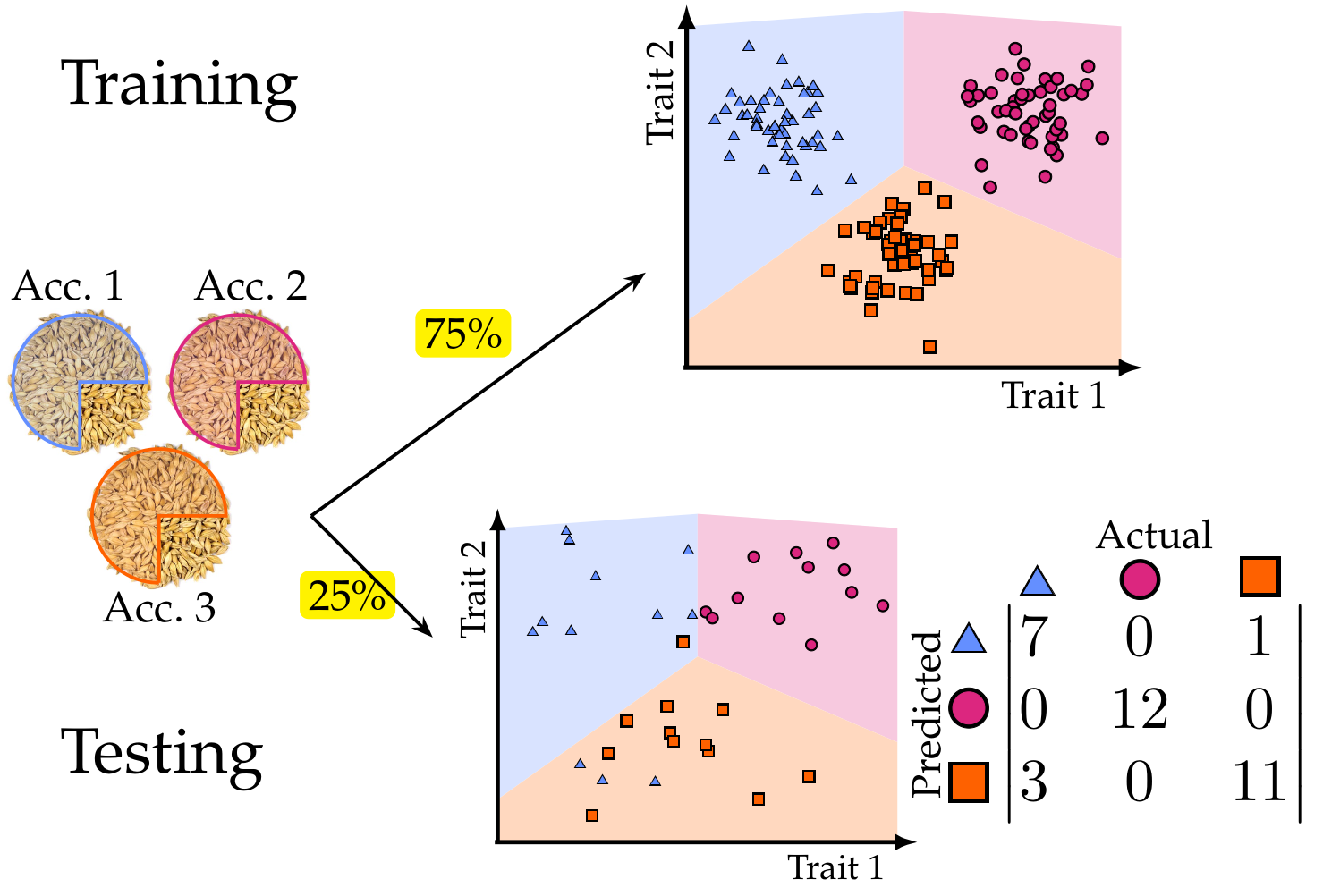 --- background-image: url("../figs/barley_world.jpg") background-size: 225px background-position: 98% 2% # Quantify the shape of barley **Goal:** Classify the **28** barley accessions solely by grain morphology. <style type="text/css"> .tg {border-collapse:collapse;border-color:#93a1a1;border-spacing:0;margin:0px auto;} .tg td{background-color:#fdf6e3;border-bottom-width:1px;border-color:#93a1a1;border-style:solid;border-top-width:1px; border-width:0px;color:#002b36;font-family:Arial, sans-serif;font-size:14px;overflow:hidden;padding:10px 5px; word-break:normal;} .tg th{background-color:#657b83;border-bottom-width:1px;border-color:#93a1a1;border-style:solid;border-top-width:1px; border-width:0px;color:#fdf6e3;font-family:Arial, sans-serif;font-size:14px;font-weight:normal;overflow:hidden; padding:10px 5px;word-break:normal;} .tg .tg-2bhk{background-color:#eee8d5;border-color:inherit;text-align:left;vertical-align:top} .tg .tg-0pky{border-color:inherit;text-align:left;vertical-align:top} .tg .tg-gyvr{background-color:#eee8d5;border-color:inherit;font-size:100%;text-align:left;vertical-align:top} </style> <table class="tg"> <thead> <tr> <th class="tg-0pky">Shape descriptors</th> <th class="tg-0pky">No. of descriptors</th> <th class="tg-0pky">F1</th> </tr> </thead> <tbody> <tr> <td class="tg-2bhk">Traditional</td> <td class="tg-2bhk">11</td> <td class="tg-2bhk">0.55 ± 0.019</td> </tr> <tr> <td class="tg-0pky">Topological</td> <td class="tg-0pky">12</td> <td class="tg-0pky">0.74 ± 0.016</td> </tr> <tr> <td class="tg-2bhk">Combined</td> <td class="tg-2bhk">23</td> <td class="tg-2bhk"><strong>0.86 ± 0.010</strong></td> </tr> </tbody> </table> ### What does topology actually measure? .pull-left[ <img src="../figs/discerning_directions.png" width="225" style="display: block; margin: auto;" /> ] .pull-right[ 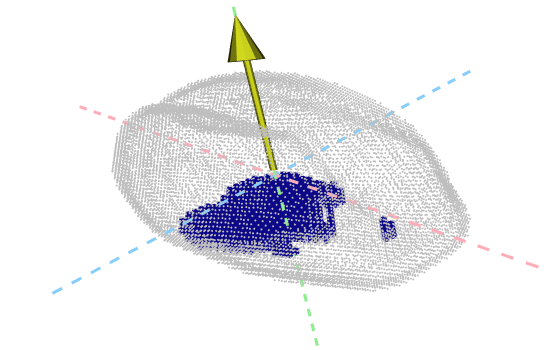 ] --- # Predicting with Semi-Supervised Learning 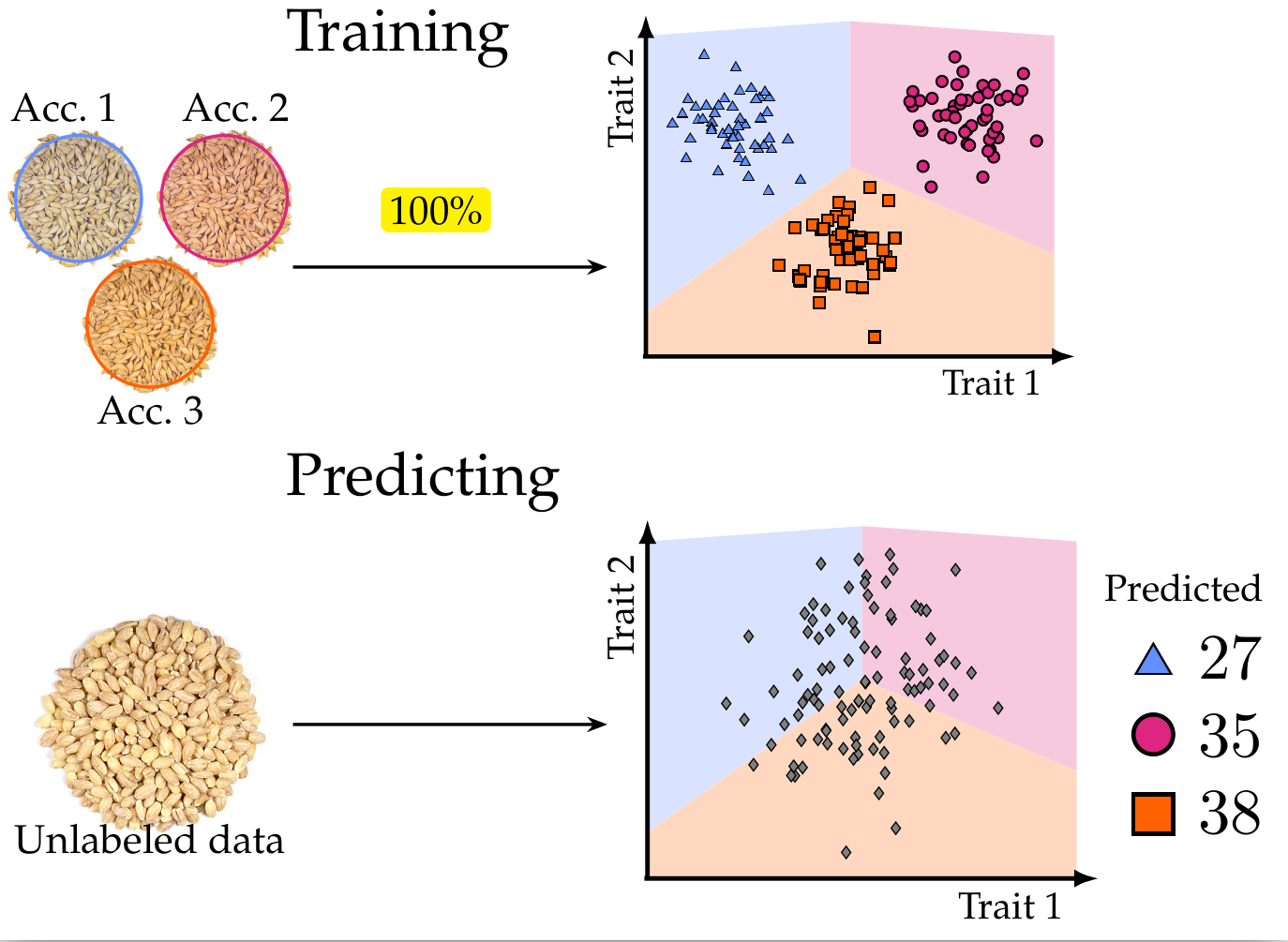 --- # Prediction into semi-supervised territory - Train an SVM with 100% of the founders `\((F_0)\)` - Classify the progeny `\((F_{18}\text{ and }F_{58})\)` to detect genotype enrichment .pull-left[  ] .pull-right[  ] --- background-image: url("../figs/comparison_lines_combined_topounscaled_d158_T16_horz.png") background-size: 900px background-position: 50% 70% ## Observe shape distribution across lines --- background-image: url("../figs/amezquita_etal_2021.png") background-size: 300px background-position: 98% 2% # Summary .left-column[ <img src="../figs/S017_L3_1.gif" width="150" style="display: block; margin: auto;" /><img src="../figs/ecc_X.gif" width="150" style="display: block; margin: auto;" /> ] .right-column[ - **TDA** captures **nuanced** morphological information that is not obvious to the naked eye. - We get the best results by **combining** both traditional and topological morphological descriptors. - We can tell **similar** population genetic dynamics by using combined **morphological** descriptors. - Seed phenotyping can be **cheaper** than genotyping. - This is one of the **first** applications of the ECT to real-world data. - First application of the ECT to **plant biology** specifically. ] --- class: center, inverse, middle # 2. If life gives you lemons... ## Modeling citrus oil gland distribution ### Comparing limes to oranges with directional statistics <img src="../../citrus/figs/ppp3.png" width="400" style="display: block; margin: auto;" /> --- ## Think of citrus as lego blocks 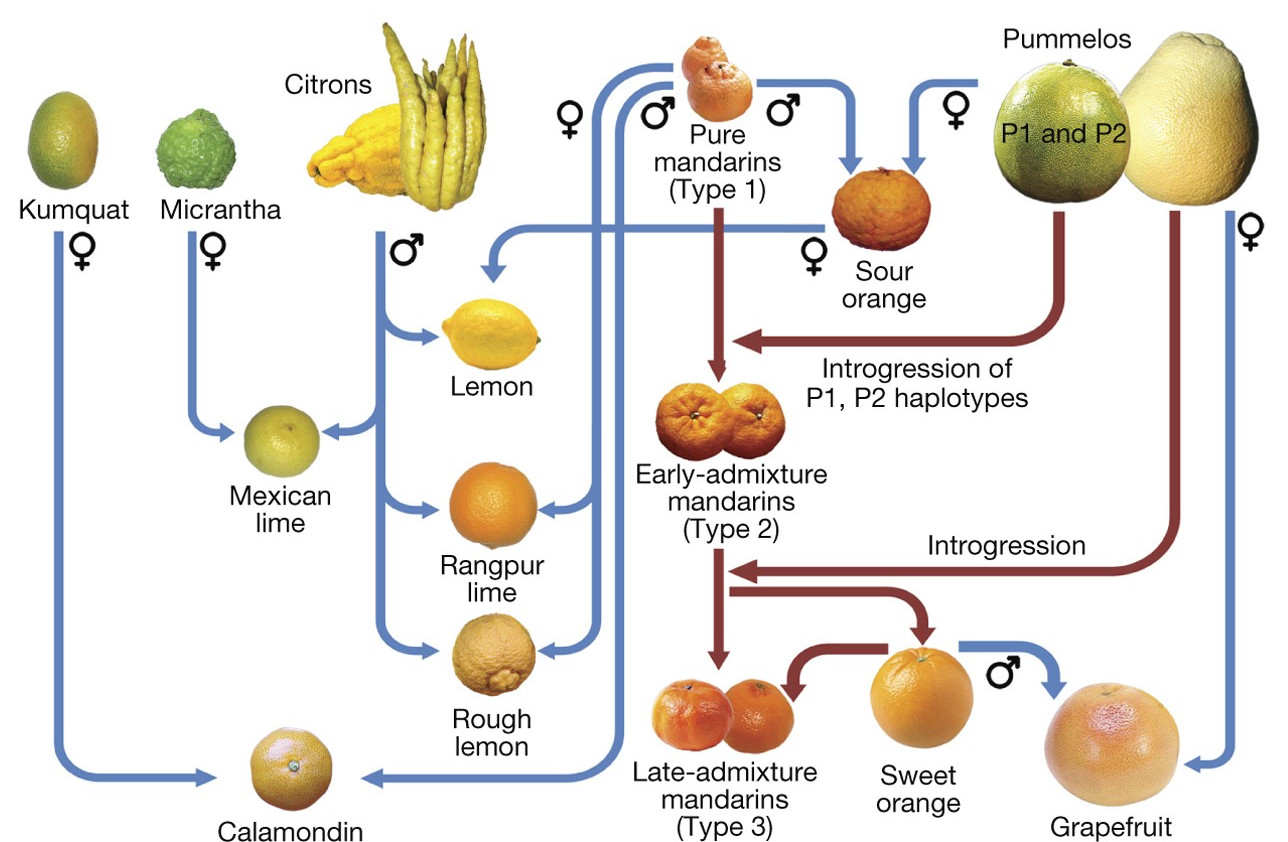 <p style="font-size: 10px; text-align: right; color: Grey;"> Credits: <a href="https://doi.org/10.1038/nature25447">Wu <em>et al.</em> (2018)</a></p> --- ## X-rays → Image Processing → Oil glands <div class="row"> <div class="column" style="max-width:37%; color: Navy; font-size: 15px;"> <img style="padding: 2px 0 2px 0;" src="../../citrus/crc_pics/crc_diversity.jpg"> <p style="text-align: center;">UCR Collaboration</p> </div> <div class="column" style="max-width:37%; color: Navy; font-size: 15px;"> <img style="padding: 2px 0 2px 0;" src="../../citrus/crc_pics/citrus_xrayct_scanning.jpeg"> <p style="text-align: center;">3D X-Ray CT scan</p> </div> <div class="column" style="max-width:25%; color: Navy; font-size: 15px;"> <img src="../../citrus/figs/lemon_development.jpg"> <p style="text-align: center;">Fruit development</p> </div> </div> <div class="row" style="color: black; font-size: 20px; font-family: 'Yanone Kaffeesatz'; margin: 0 auto;"> <div class="column" style="max-width:20%;"> <img src="../../citrus/figs/SR01_L01_black_endocarp.gif"> <p style="text-align: center;"> Endocarp </p> </div> <div class="column" style="max-width:20%;"> <img src="../../citrus/figs/SR01_L01_black_rind.gif"> <p style="text-align: center; padding:5px 0;"> Rind </p> </div> <div class="column" style="max-width:20%;"> <img src="../../citrus/figs/SR01_L01_black_exocarp.gif"> <p style="text-align: center;"> Exocarp </p> </div> <div class="column" style="max-width:20%;"> <img src="../../citrus/figs/SR01_L01_black_oil_glands.gif"> <p style="text-align: center;"> Oil glands</p> </div> <div class="column" style="max-width:20%;padding: 10px 0 0 20px;"> <p> <li>53 different citrus species</li><br> <li>All fundamental lego blocks and several relatives and hybrids of interest</li><br> <li>166 individual fruits</li> </p> </div> </div> --- background-image: url("../../citrus/figs/lambert_equal_area_N.gif") background-size: 150px background-position: 98% 1% class: middle ## Citrus modeling: Sour and sweet orange <img src="../../citrus/figs/SR01_CRC3289_12B-19-9_L00_lambproj.jpg" width="800" style="display: block; margin: auto;" /><img src="../../citrus/figs/SW03_CRC1241-B_12B-4-3_L00_lambproj.jpg" width="800" style="display: block; margin: auto;" /> --- # Citrus projections 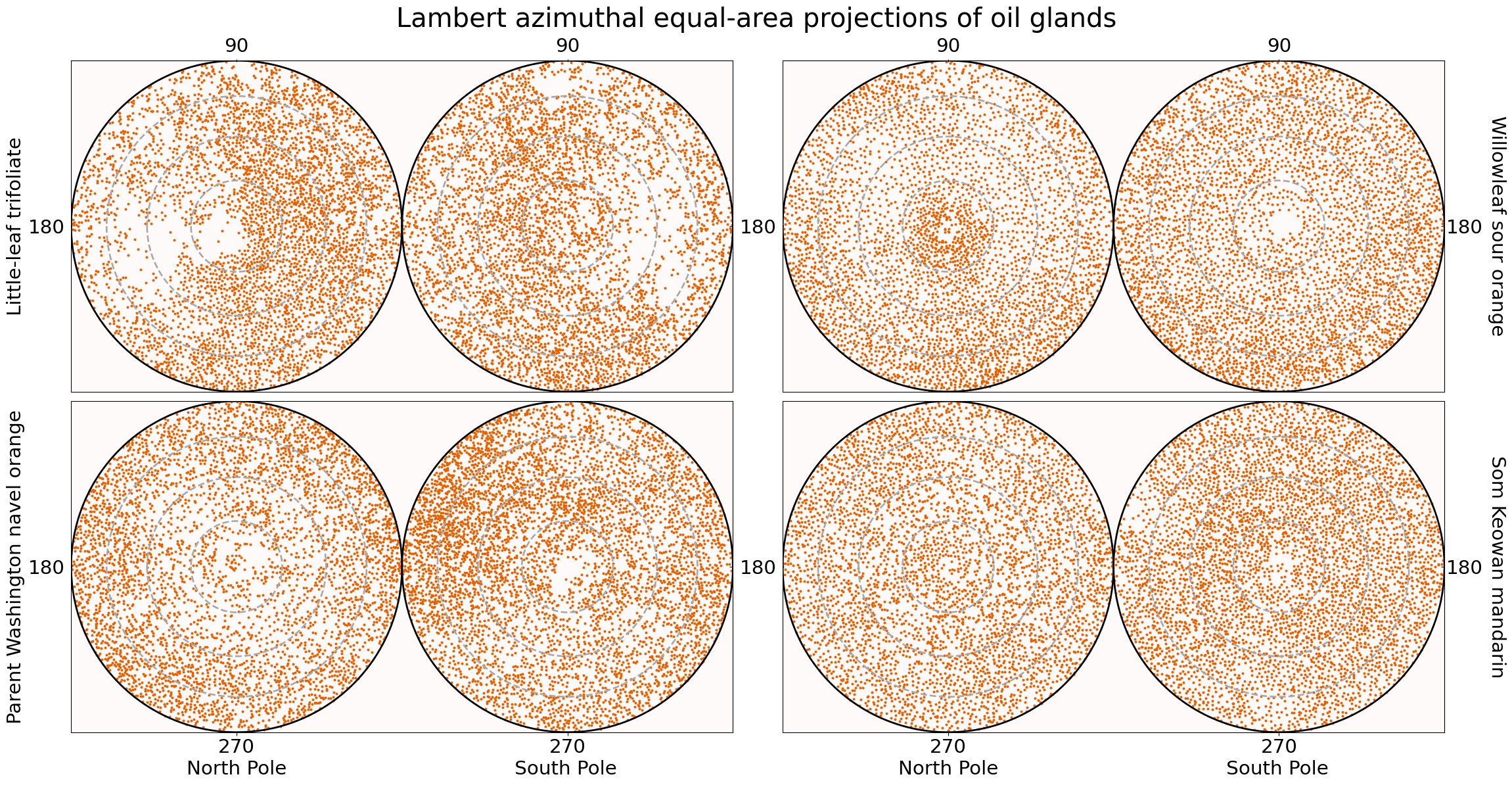 --- background-image: url("../../citrus/ellipsoids/GarciaPortugues_etal_2020a.png") background-size: 200px background-position: 99% 1% # Uniform and rotationally symmetric spherical distributions 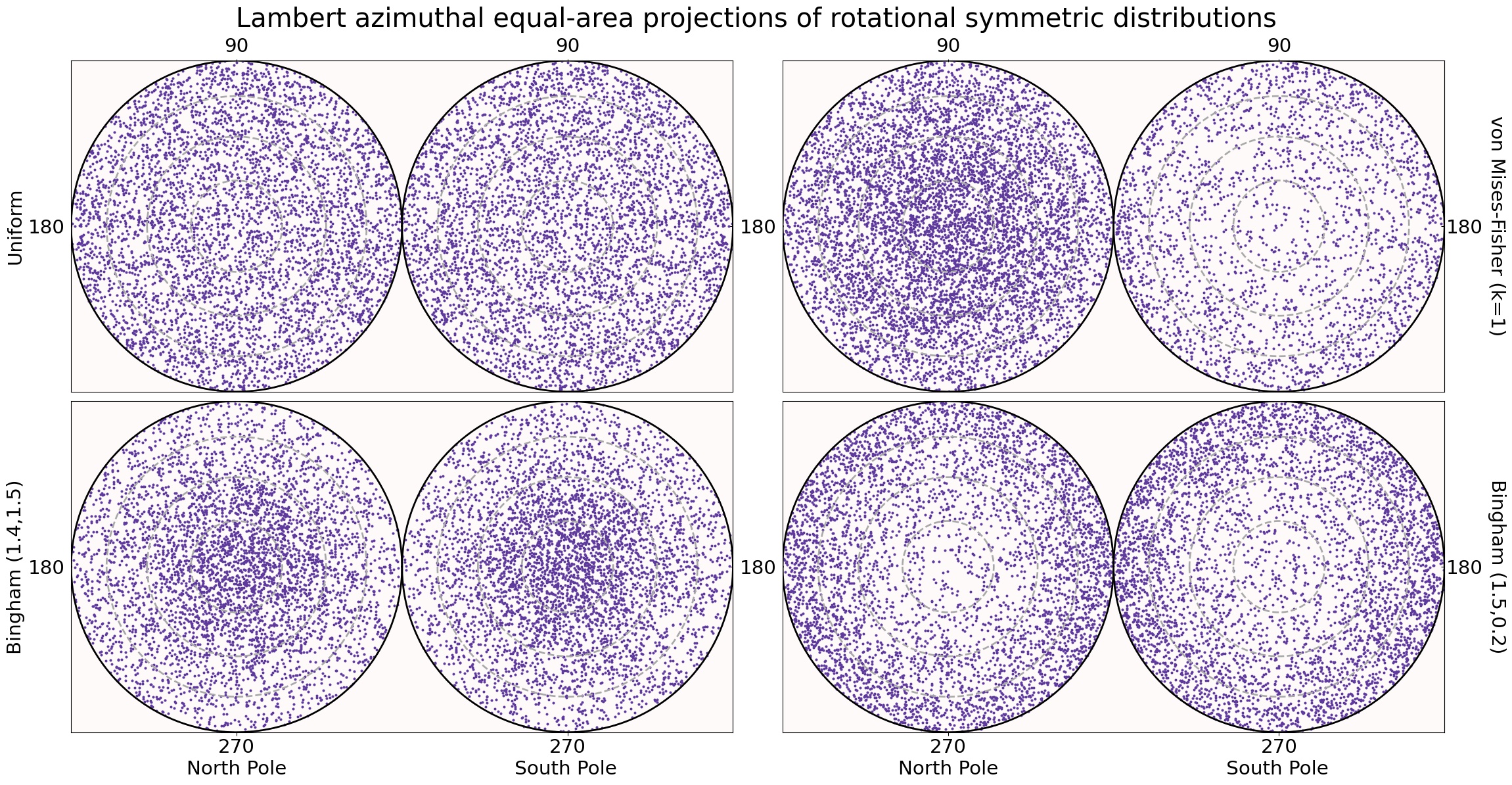 - A battery of tests reveal that citrus oil glands are neither uniformly nor rotationally symmetrically distributed. --- background-image: url("../../citrus/ellipsoids/GarciaPortugues_2013.png") background-size: 150px background-position: 95% 3% # Spherical Kernel Density Estimators 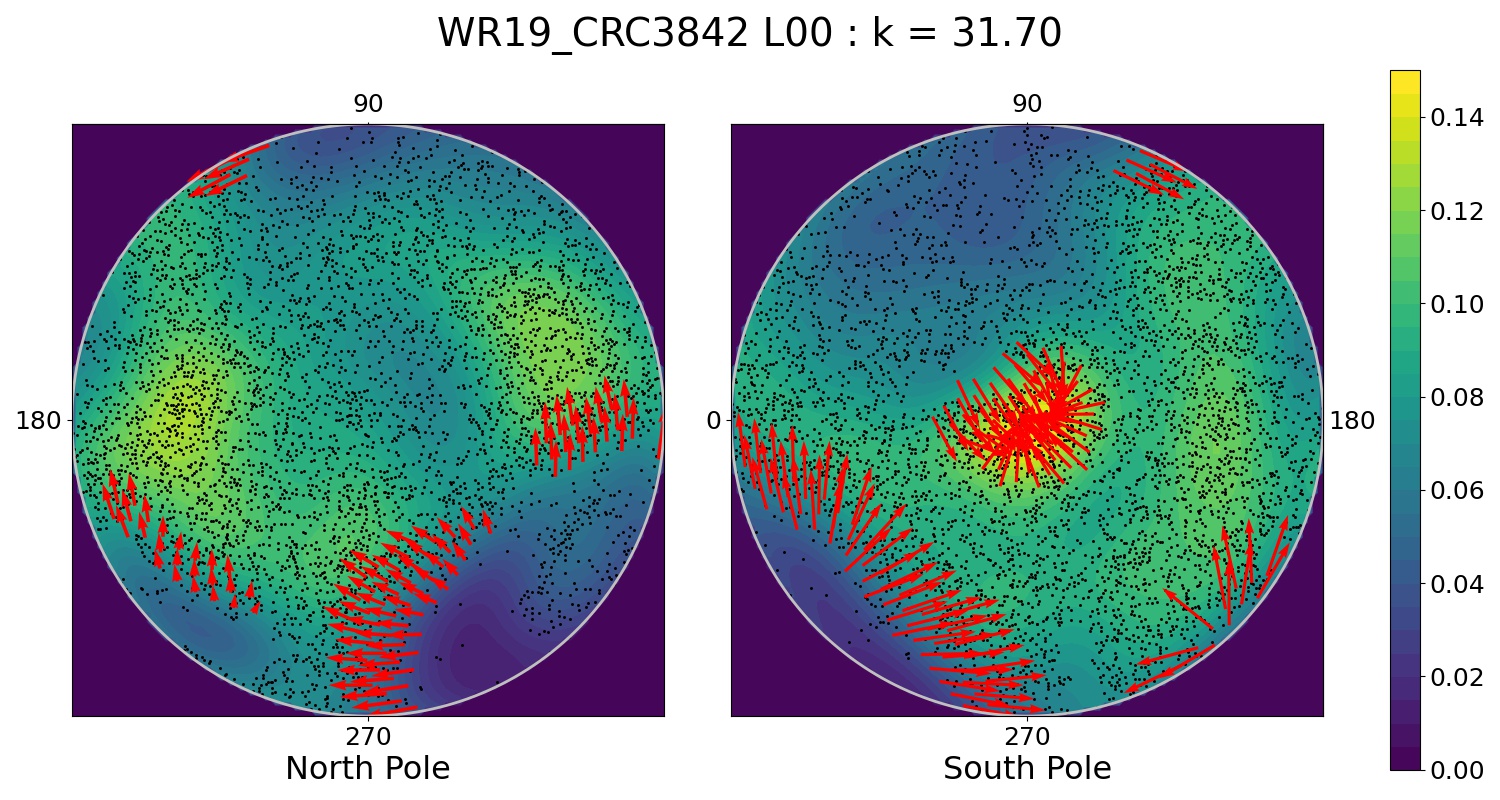 - Oil glands of a papeda - Red arrows indicate the most significant gradient values for the density function - Concentration parameter `\(k\)` is chosen to be optimal --- background-image: url("../../citrus/figs/ppp3.png") background-size: 225px background-position: 95% 3% # Summary .left-column[ <img src="../../citrus/crc_pics/citrus_amblycarpa.jpg" width="150" style="display: block; margin: auto;" /><img src="../../citrus/figs/SR01_L01_black_exocarp.gif" width="150" style="display: block; margin: auto;" /><img src="../../citrus/figs/SW03_CRC1241-B_12B-4-3_L00_lambproj_v.jpg" width="150" style="display: block; margin: auto;" /> ] .right-column[ - It is possible to **compare** ~~apples~~ limes to oranges, despite diversity in shapes and sizes. - We can define the non-parametrical **distribution** of oil glands for most of the citrus. - **First** time citrus shape has been examined using X-ray CT scans. - AFAIK, this is also the **first** time directional statistics have been **applied** to plant biology. ] --- class: inverse, center, middle # 3. All about cracks, kernels, and domestication ## In a nutshell <img src="https://upload.wikimedia.org/wikipedia/commons/3/39/Benutzung_eines_Nussknackers.gif" width="200" style="display: block; margin: auto;" /> --- # The wal(nu)tzing nutcracker! <div class="row" style="font-family: 'Yanone Kaffeesatz'; margin: 0 auto; font-size:22px"> <div class="column" style="max-width:25%;"> <img src="../../walnuts/figs/IMGA04011.jpg"> <p style="text-align: center;">148 accessions</p> </div> <div class="column" style="max-width:42%;"> <img src="../../barley/figs/x3000_setup.jpg"> <p style="text-align: center;">1301 walnuts scanned</p> </div> <div class="column" style="max-width:33%;"> <img src="../../walnuts/figs/pat_walnut_crack_detail4.jpg"> <p style="text-align: center;">Qualitative data for crackability</p> </div> </div> <div class="row" style="font-size: 22px; font-family: 'Yanone Kaffeesatz'; margin: 0 auto;"> <div class="column" style="max-width:20%;"> <img src="../../walnuts/figs/2014SBa_R5_T81_shell_1.gif"> <p style="text-align: center; margin: 0.5ex;">Shell</p> </div> <div class="column" style="max-width:20%;"> <img src="../../walnuts/figs/2014SBa_R1_T3_001_air.gif"> <p style="text-align: center;margin: 0.5ex; ">Air</p> </div> <div class="column" style="max-width:20%;"> <img src="../../walnuts/figs/2014SBa_R1_T3_001_vein.gif"> <p style="text-align: center;margin: 0.5ex; ">Packing tissue</p> </div> <div class="column" style="max-width:20%;"> <img src="../../walnuts/figs/2014SBa_R5_T81_meat_2.gif"> <p style="text-align: center;margin: 0.5ex;">Kernel</p> </div> <div class="column" style="max-width:20%; padding: 0 0 0 5px"> <p style="margin:5px 0 0 0; text-align:left"> ▸ Individuals separated manually<br> ▸ Tissues separated with watershed segmentation<br> ▸ 38 traditional shape and size descriptors </p> </div> </div> --- # The power of allometry: `\(\;y = e^bV_N^m\)` For most living organisms, different tissues grow at different rates with respect to each other. Growth does **not** scale linearly but following a power law. <div class="row" style="color: black; font-size: 20px; font-family: 'Yanone Kaffeesatz'; margin: 0 auto;"> <div class="column" style="max-width:33%;"> <img src="../../walnuts/figs/nut_convex_volume_vs_nut_volume.png"> <p style="padding: 0 2ex 0 0;">Walnut changes dramatically after its diameter is larger than 1.6cm</p> </div> <div class="column" style="max-width:33%;"> <img src="../../walnuts/figs/air_volume_vs_nut_volume.png"> <p style="margin: 3px 0 0 0; padding: 0 2ex 0 0;">If nut volume increases by 2x, then air volume increases by 2.3x</p> <p style="padding: 0 2ex 0 0;">Walnut diameter is below 16cm</p> </div> <div class="column" style="max-width:33%;"> <img src="../../walnuts/figs/kernel_volume_vs_nut_volume.png"> <p style="margin: 1.1ex 0 0 0; padding: 0 2ex 0 0;">If nut volume increases by 2x, then kernel volume only increases by 1.8x</p> </div> </div> There are biophysical constraints at play in walnut development --- ## Correlation with traits of interest  .pull-left[ **Walnuts with more kernel filling ratio have:** - Less air filling ratio - Smaller volume - Smoother shells - Kernel overall shape is more convex - But it also has numerous deep but thin grooves. ] .pull-right[ **Walnuts with thinner shells have:** - Less total shell volume and shell ratio - More air filling ratio - Smoother shells ] --- <h3 style="line-height:0">Descriptors that explain the most crackability variance</h3> <img src="../../walnuts/figs/qual_EaseOfRemoval_scatter_2x4.jpg" width="725" style="display: block; margin: auto;" /><img src="../../walnuts/figs/qual_ShellStrength_scatter_2x4.jpg" width="725" style="display: block; margin: auto;" /> --- ## Can you spot the Earliest Himalayan accession? <img src="../../walnuts/figs/pat_walnut_crack_crop.jpg" width="500" style="display: block; margin: auto;" /> This one accession is the most heterozygous wild type of the bunch --- ## The Earliest Himalayan accession breaks the pattern <img src="../../walnuts/figs/NewStuke_R1_T18_vs_2014SBa_R7_T26.png" width="725" style="display: block; margin: auto;" /> -- <img src="../../walnuts/figs/qual_85-023-2_scatter.jpg" width="725" style="display: block; margin: auto;" /> - The kernel of Earliest has deeper, wider cavities - Does it refer to the cavity located at the proximal end? --- background-image: url("https://toasterovenlove.com/wp-content/uploads/Stirred-nuts-on-pan.jpg") background-size: 180px background-position: 98% 2% # Summary .left-column[ <img src="../../walnuts/figs/2014SBa_R5_T81_meat_2.gif" width="725" style="display: block; margin: auto;" /><img src="../../walnuts/figs/kernel_volume_vs_nut_volume.png" width="725" style="display: block; margin: auto;" /> ] .right-column[ - There are serious **biophysical** constraints that govern the kernel filling ratio. - Larger walnuts tend to have **less** kernel and **more** air relative to their size. - Walnuts with thinner shells also have **more** air. - **Less** packing tissue in general corresponds to better **crackability**. - The shape of **domestication** is quite **nuanced**: it is a hard nut to crack. - AFAIK, this is the first time that **allometry** has been studied for walnut fruit. - AFAIK, first time packing tissue volume and **convexity** indices have been measured. ] --- class: center, inverse, middle # 4. Future directions ## Barley scratching the surface --- # Grains, oranges, and nuts oh my! .left-column[ <img src="../figs/S017_L3_1.gif" width="100" style="display: block; margin: auto;" /><img src="../../citrus/figs/SR01_L01_black_exocarp.gif" width="100" style="display: block; margin: auto;" /><img src="../../walnuts/figs/2014SBa_R5_T81_meat_2.gif" width="100" style="display: block; margin: auto;" /> ] .right-column[ - Identify specific **molecular markers** corresponding to topological traits of **barley seeds**. - Develop a high-throughput **seed phenotyping** pipeline for seed morphology. - Compute a pairwise distance matrix for citrus oil gland **distributions**. - Use **persistent homology** as an alternative to quantify the distribution of such oil glands. - Measure the size and volume of the central **cavity** of the walnut kernel. - Use the ECT or a similar approach to quantify **nuances** present in the kernel. ] --- background-image: url("https://gradschool.missouri.edu/wp-content/uploads/2019/02/MU_UnitSig_GraduateSchool_rgb_std_horiz.png") background-size: 330px background-position: 98% 2% ## Future research at Mizzou .pull-left[ The shape of maize roots <img src="../../psd/figs/Maiz_root_Dario.jpeg" width="200" style="display: block; margin: auto;" /> The shape of dodder movement <img src="https://i.makeagif.com/media/11-28-2013/qmlphv.gif" width="300" style="display: block; margin: auto;" /> ] .pull-right[ Dabbing into UAV imagery for sorghum high-throughput phenotyping 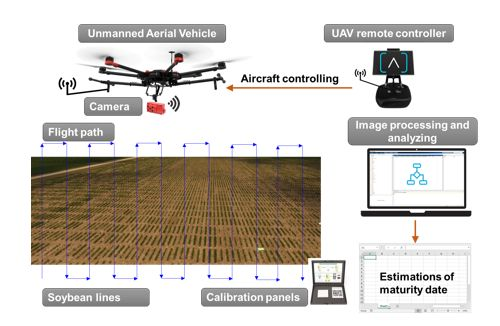 - David Mendoza Cozatl - Robert Sharpe - So-Yon Park - Andrew Scaboo ] --- background-image: url("../../tutorials/figs/plantspython22_01.png") background-size: 225px background-position: 99% 1% # Plants & Python _a la_ Mizzou .pull-left[   ] .pull-right[ - **Inspired by the current Plants & Python course @ MSU** - Offered in hybrid format between MSU and UNAM - **HRT 841**: Foundation in Computational and Plant Science - **UNAM Temas Selectos**: Bioinformática y Minería de Datos con Python - Freely available material in jupyter notebook format. - Material in English and Spanish. ] --- background-image: url("../../img/phd_institutional_logos.jpg") background-size: 500px background-position: 95% 1% class: inverse ## Thank you! <div class="row" style="margin-top: -25px;"> <div class="column" style="max-width:17.5%; font-size: 13px;"> <img style="padding: 0 0 0 0;" src="https://i1.rgstatic.net/ii/profile.image/607374528233472-1521820780707_Q128/Elizabeth-Munch.jpg"> <p style="text-align: center; color: White">Liz Munch<br>(MSU)</p> <img style="padding: 0 0 0 0;" src="https://alga.win.tue.nl/images/staff/tim.jpg"> <p style="text-align: center; color: White">Tim Ophelders<br>(Utrecht)</p> <img style="padding: 0 0 0 0;" src="https://publons.com/media/thumbs/academic/photos/252a7116-ee14-4a5e-b44c-7c62ac11e217.png.200x200_q95_crop_detail_upscale.png"> <p style="text-align: center; color: White">Jacob Landis<br>(Cornell)</p> </div> <div class="column" style="max-width:17.5%; font-size: 13px;"> <img style="padding: 0 0 0 0;" src="https://www.canr.msu.edu/contentAsset/image/9ae9777d-157c-46e6-9f12-d062ad35671e/fileAsset/filter/Jpeg,Resize,Crop/jpeg_q/80/resize_w/400/crop_x/0/crop_y/45/crop_w/400/crop_h/400"> <p style="text-align: center; color: White">Dan Chitwood<br>(MSU)</p> <img style="padding: 0 0 0 0;" src="https://i1.rgstatic.net/ii/profile.image/926632407748609-1597937790454_Q128/Michelle-Quigley.jpg"> <p style="text-align: center; color: White">Michelle Quigley<br>(MSU)</p> <img style="padding: 0 0 0 0;" src="https://www.plantsciences.ucdavis.edu/sites/g/files/dgvnsk1736/files/styles/sf_profile/public/images/person/pjbrown_1.jpg?h=9707347b&itok=gDYXMHJj"> <p style="text-align: center; color: White">Pat Brown<br>(UC Davis)</p> </div> <div class="column" style="max-width:13%; font-size: 13px;"> <img style="padding: 0 0 0 0;" src="https://plantbiology.ucr.edu/sites/g/files/rcwecm1001/files/styles/scale_225/public/Koenig.jpg?itok=P92Ow61p"> <p style="text-align: center; color: White">Dan Koenig<br>(UC Riverside)</p> <img style="padding: 0 0 0 0;" src="https://iigb.ucr.edu/sites/g/files/rcwecm5716/files/styles/scale_225/public/Seymour.jpg?itok=pnUK_orh"> <p style="text-align: center; color: White">Danelle Seymour<br>(UC Riverside)</p> </div> <div class="column" style="width:10%; font-size: 24px;"> </div> <div class="column" style="max-width:40%; font-size: 24px; line-height:1.25"> <p style="text-align: center; color: White"><strong>Email</strong></p> <p style="text-align: center; color: Yellow">amezqui3@msu.edu</p> <p style="text-align: center; color: White"><strong>Slides</strong></p> <p style="text-align: center; color: Yellow">bit.ly/mu_22</p> <p style="text-align: center; color: White"><strong>References</strong></p> <p style="text-align: center; color: White; font-size: 12px; text-align:left"> <strong>E.A.</strong> <em>et al.</em> (2022) The shape of aroma: measuring and modeling citrus oil gland distribution. <a href="https://doi.org/10.1002/ppp3.10333" target="_blank">DOI: 10.1002/ppp3.10333</a> </p> <p style="text-align: center; color: White; font-size: 12px; text-align:left"> <strong>E.A.</strong> <em>et al.</em> (2021) Measuring hidden phenotype: Quantifying the shape of barley seeds using the Euler Characteristic Transform. <a href="https://doi.org/10.1093/insilicoplants/diab033" target="_blank">DOI: 10.1093/insilicoplants/diab033</a> </p> <p style="text-align: center; color: White; font-size: 12px; text-align:left"> VanBuren, R. <em>et al.</em> (2022) Plants & Python: A series of lessons in coding, plant biology, computation, and bioinformatics. <a href="https://doi.org/10.1093/plcell/koac187" target="_blank">DOI: 10.1093/plcell/koac187</a> </p> <p style="text-align: center; color: White; font-size:15px; line-height:1.1">Slides made in <a href="https://bookdown.org/yihui/rmarkdown/xaringan.html" target="_blank">xaringan</a>.</p> </div> </div> --- class: inverse, center, middle # Questions? 